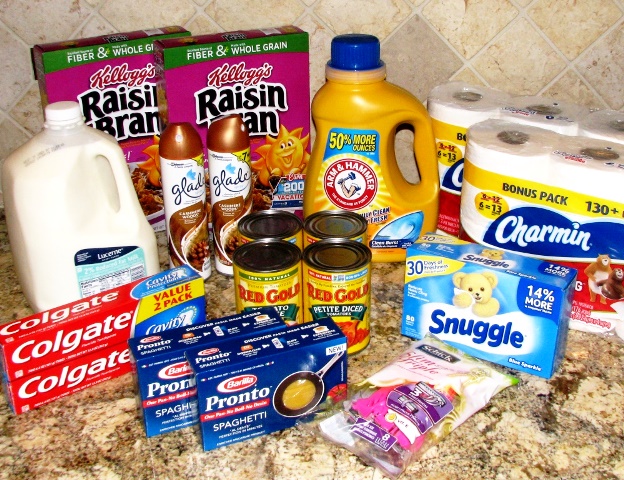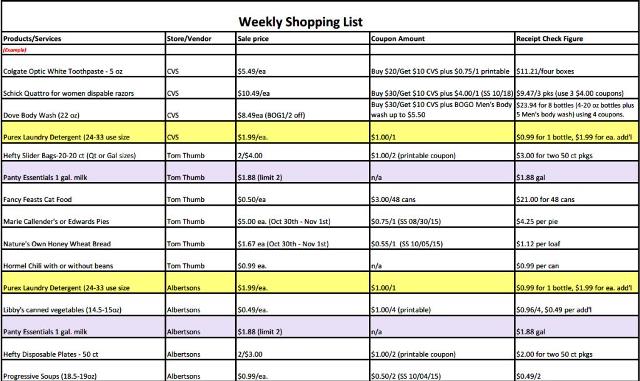If you’ve been following along and have already read Part I and Part II of this series, you might be wondering by now how everything fits together. After all, we’ve talked about how to file the coupon inserts from the weekly newspaper, develop a weekly shopping list using the local sale papers for the stores in the area, and about a new method of shopping whereby we only buy items on sale AND match coupons up with those sale priced items to help pay for it all, but none of that just magically happens right? Somehow, we need to pull it all together in a way that we’re able to make use of those great coupons and sales and yet not spend so much time doing it that we decide it’s not worth the effort. In Part I, I committed that by the time we were done, I’d have shown how I’ve already done all the hardest work upfront – of researching different couponing systems, testing it all out using my own time and money, and then laid it all out simply so you could dive right in and to start seeing REAL money flow back into your pocket book and that of your family’s. Today, that is exactly what I’ll be doing. I’ll share with you an example of how I tie everything together and am consistently saving 50% (or more) on everything I buy, while spending about 3 hours a week to accomplish it. I will also give you a couple of free tools to use so that you can begin very quickly to replicate those results as well.
What I do is this – once I’ve established my coupon files (from Part II), I’m ready to make up my shopping list and start matching up sale priced items with available coupons. Once a week, I set aside about an hour to scan the weekly sale papers and make up a shopping list. I will list any items that I must purchase, like milk or bread, and then I will go through the weekly sale papers of the 3 or 4 stores I prefer to shop at, scanning for items I normally buy that are on sale and that if I also have coupons for, could be an item I’d want to stock up on this week. (The stores I prefer are ones that routinely have good sales of the kinds of products I purchase. Starting out, you’ll want to study all the sale papers you receive, but within a short time, you’ll notice a few will rise to the top, and those will become your favorites.) Below is an example of my list for this week. The highlighted lines are ones where there are identical items being offered at the same sale price by more than one store. (This is fairly common, and is especially useful information when an item is offered as a limited quantity sale item.) For example, milk was on sale for $1.99 at two different stores this week. Although I don’t have any coupons for milk, it’s already at a great price, so if I do end up needing to pick up some milk this week, I will do so from one of the two stores on my list. (It’s unlikely I’ve even buy milk this week, however, since I caught a sale last week where if you buy four boxes of cereal, you get a free gallon of milk. I had coupons for all the cereal so I stocked up on cereal and got a free gallon of milk too!)
The method you use to make out your shopping list is completely up to you. You can manually write it out on a spiral bound notebook, you can do it on an Excel spreadsheet and print it out from your computer, or you could put together a form, like this free printable one (My Weekly Shopping List), and use that. Whatever you choose, if it’s one you’ll actually use, that’s the right method for you.
As I consider adding sale priced items I normally buy to the list, I also check for available coupons, using this free coupon database. If a coupon is available for the item, the database will give the coupon insert type (i.e. SS-Smart Source, RP-Red Plum, and PG-Proctor & Gamble), and the date, which is exactly how I’ve previously filed everything, using the coupon filing system from Part II. Just go to the file for that date, and clip the coupon(s) for that item to take with you to the store. (Everything else remains in the file, for future use.) Note: This database is also a great source for additional printable coupons, which you can also take advantage of, and often use in addition to the coupons you obtain from the newspaper.
Once your shopping list is complete and you’ve clipped just the coupons you need, the final (and everyone’s favorite) step, is to head to the store and to purchase everything listed on your shopping list. Remember that everything is already on sale and you’re going to use coupons to pay for it all, so it’s going to be a great shopping day!
Pictured below is a sample basket of items, which I purchased using this system for just $19.73. The average retail price of the 18 items pictured is $48.40, but I bought all of it for less than half of that, saving just under 60% on a whole bunch of everyday things.
I started out this Extreme Couponing series talking about how most people pay too much for everyday things. After reading this, what do you think? Could it be that, like me, you been guilty of spending more than you have to for most things? Does that knowledge make it more or less likely that you’ll try using coupons in the future?
I hope you’ve enjoyed this quick initiation into to how to use coupons to help add real money back into yours and your family budget. If you have enjoyed it (or any of my other blog posts), and have found it interesting, helpful, or useful to your life in some way, please be sure to leave a comment and let me know, so I can continue to work at providing the kinds of information you most enjoy.
As always, you can subscribe for free to the blog to begin to receive all my upcoming posts, as they become available, and have them delivered directly to your email account by using your email to subscribe in the ‘Get new posts by email’ section of the blog.
Thanks for stopping by!
~ Paula Reyne 🙂

